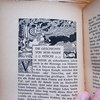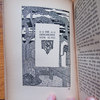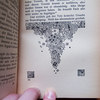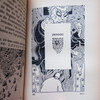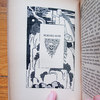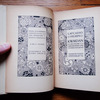The art of the book: Emil Ortik illustrating Lafcadio Hearn

A little while ago, while checking whether a local second-hand book shop had got any new photobooks in (it hadn’t) I noticed there was a largeish pile of German language book, somewhat shoddily stacked on the floor. It’s hard to get German language books in the US, so I had a peek at what they had. Most of it had been published in the 1970s, with a few dating back way earlier. There wasn’t much that interested me, with the exception of some old books by Lafcadio Hearn. I usually don’t buy books in translation if I can read the original language, but a quick glance into these had me get these. Printed in 1921, they all are rather lavish productions. (more)
The books are in a pretty good shape given their age. But I didn’t want to put them on my scanner, so I photographed some pages. Each book is illustrated very beautifully as you can see in these images. The title page says that the book’s ornaments (my translation for the German “Buchschmuck”) were done by Emil Orlik, an artist I had not heard of before. (If you look at that page closely, you’ll notice it claims that Orlik also translated the books, which, however, is not true. The translator is given as Berta Franzos.) I don’t usually look for old books too much, so I don’t know how commonly old books were illustrated this way. I do not, however, remember seeing a whole lot of book like these ones.
There is a lot of talk about ebooks now. There is a lot of talk about how we’re (supposedly) going to lose the physical object. Seeing these books had me think that we might be justified to bemoan the transition from books to ebooks. But I think we should also be aware of the fact that most contemporary books on paper don’t compare too well with older productions. The Lafcadio Hearn books might be an extreme example, of course. But today’s books as objects are rather reduced versions of what books used to be.
In fact, wouldn’t it make much more sense to complain about today’s books being so uniformly bland (with effort mostly put into the covers)?
I thought I’d bring this up, not because I want to pine for the “good old days” (1921 in Germany certainly wasn’t such a grand time if you know your history). But a lot of the talk about our transition from a purely physical world to one that also has a significant electronic component seems to one-dimensional, as if once you make the jump from a book to an ebook the end of the book is nigh. But it’s not. In fact, given that most book really are just text on paper - without any of the illustrations you can find in Hearn’s books - is looking at that text on some sort of computer such a big loss?
In fact, I’m cautiously hopeful that ebooks might bring back part of what one can find in these illustrated books - in whatever form possible - since a computer allows for all kinds of additional materials (multimedia). And ultimately, reading or looking at a book is an experience, with the handling of the book being a rather small part. The real experience will be delivered by whatever it is that authors (here including photographers) will add to the original content. I’m looking forward to seeing where that’s going.
